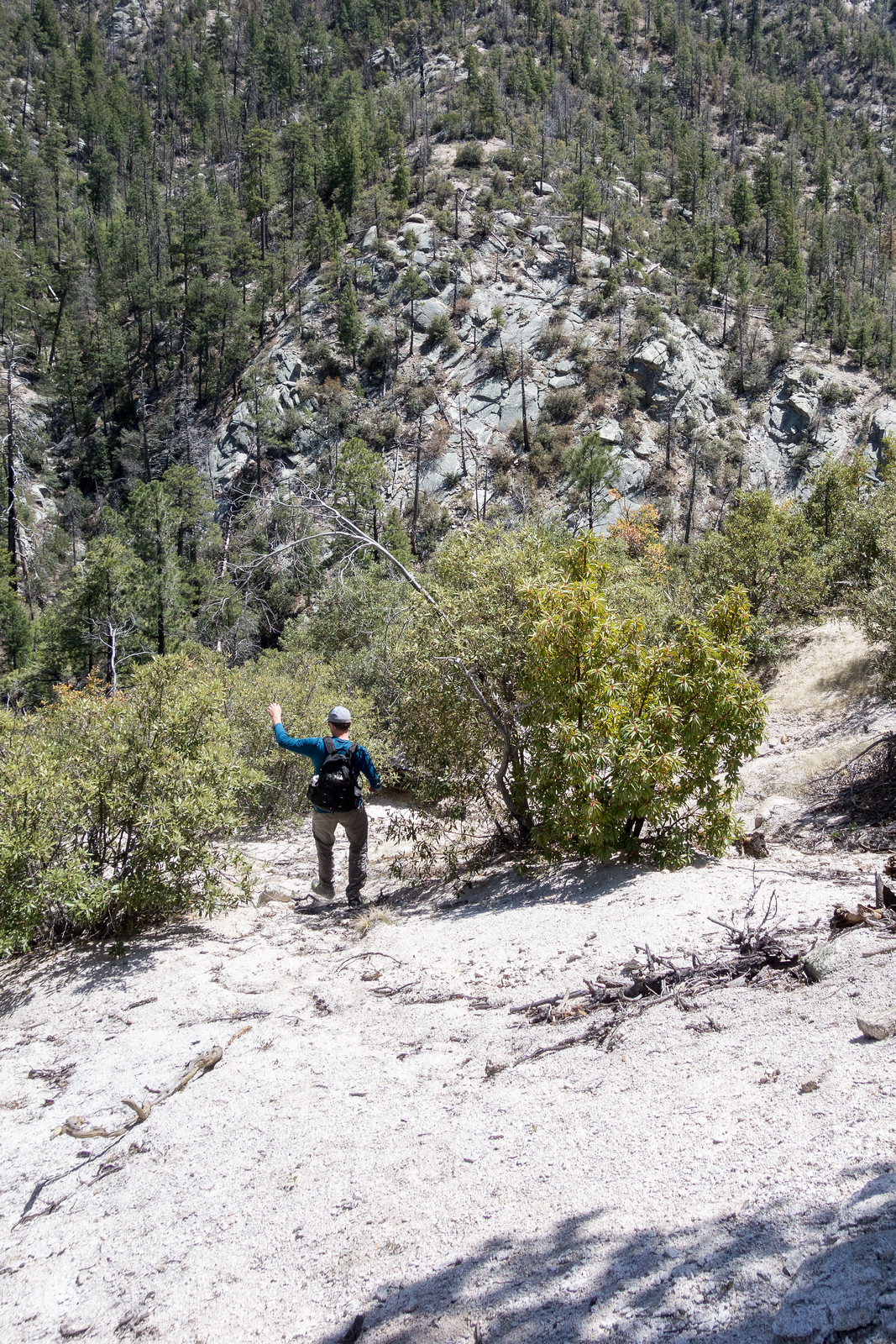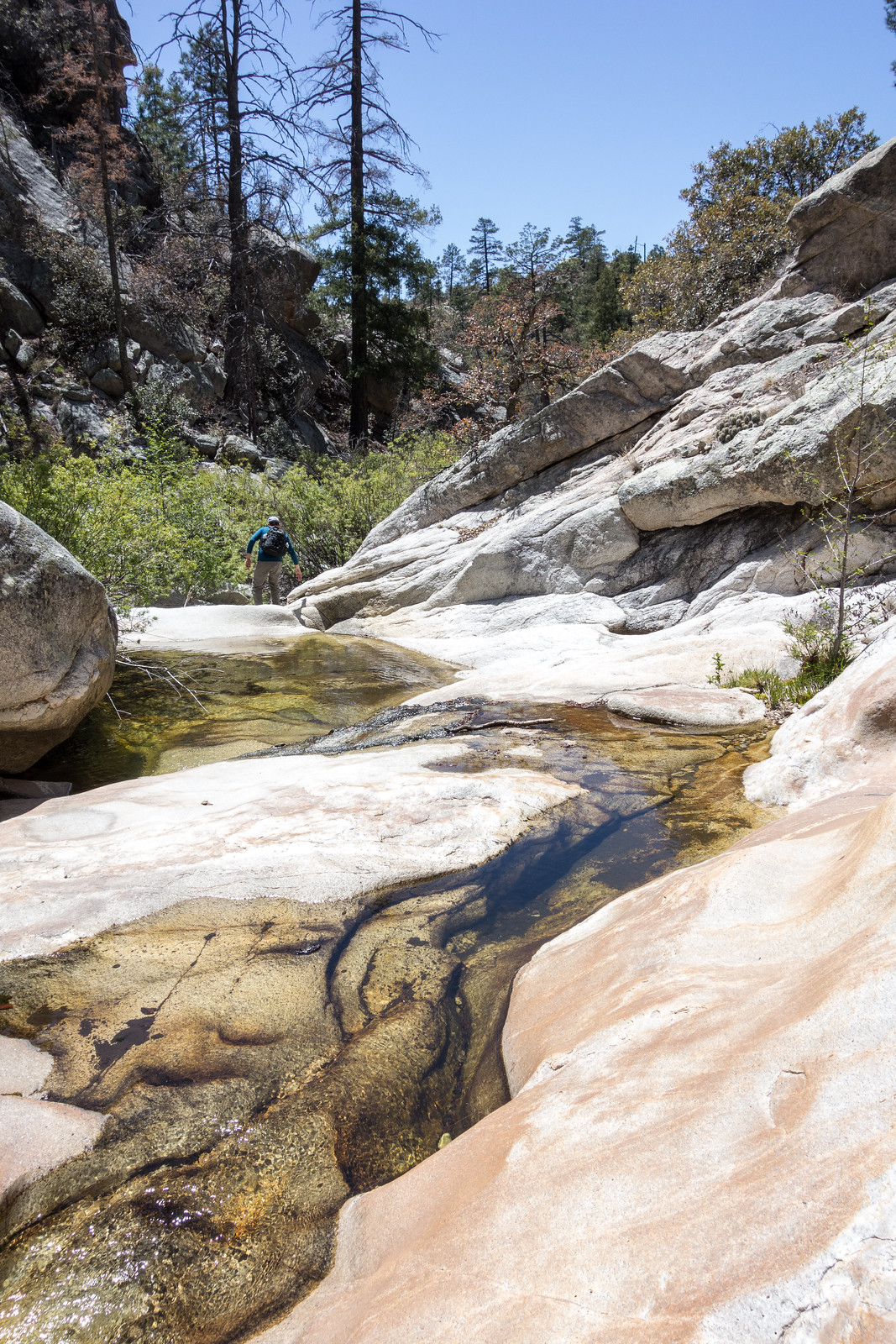Brinkley Point, perched in the middle of the Santa Catalina Mountains, is protected by an off trail approach and a modest distance and elevation profile that don’t really lend themselves to bragging. A beautiful sunset, a wait in the fading light, and then the real show begins – moonlight on the inner basins, ridges and canyons. Alone on the small point I take pictures, briefly watch headlamps on the East Fork Trail and let my mind wander. Early in the AM I wake up to take a few more pictures and find the sky covered by clouds reflecting the city lights.
box camp trailhead
Box Camp Trail, Hutch’s Pool, out to Prison Camp – 9/23 and 9/24/2018
Pictures from last Fall – watery Hutch’s Pools, a bright moonrise from the West Fork and a beautiful night – but what really sticks in my mind is the lower half of the Box Camp Trail. The rough trail hides other footsteps – hard to guess the last time someone has been here – an hour? a week? Nice to be alone and wonder!
Black Blobs, Ghost Camps – 1/7/2019
A message from the amazing Arizona based photographer Erini Pajak (Instagram) let me know that according to Google a strange black blob had appeared in the Santa Catalina Mountains. I was, of course, 99.999999% sure that this was something mundane like an unfortunate Google maps omission for a government agency or map data oddity/error and not a reflection of the real world. Thinking otherwise is probably the territory of theories like ‘blacked out because of an alien landing’ or ‘blacked out because new high resolution imagery clearly shows the Iron Door of mine-with-the-Iron-Door fame and Google is in the process of claiming mineral rights’ – but Google’s power and reach these days is such that sometimes it seems their information creates and influences reality rather than just reflecting it… So it was with 0.000001% relief that my recent photographs of Cathedral Rock didn’t show a black blob covering the peak!
The images above show the black blob as seen on my screens in early January – I still see the blob on Google Maps, but changing the imagery date in the desktop version of Google Earth immediately shows the expected imagery (shown below). I can’t find any hint of the black blob in Microsoft’s Bing Maps, Gaia GPS and Backcountry Navigator Pro so it appears that the Cathedral Rock area is safe…
I suspect that any map large and detailed enough to be interesting – printed or digital – has errors, or at the very least representations that are historically accurate but not currently relevant…
Witness the Ghost Campgrounds of the Santa Catalina Mountains – current results that come up if you zoom in and search for ‘campgrounds’ in Google Maps…
From left to right:
Box Camp Trailhead: a great place to start a hike and a decent place to backpack from – but there is no campground or camping in the trailhead proper…
Bear Wallow Campground: A beautiful area for a hike, probably the best single spot for Fall color in the Santa Catalina Mountains and the first official campground on the mountain (established in 1921!) – but it has been closed to camping for decades…
Santa Catalina Recreation Area: Well, I guess unlike the previous two examples you could legally camp at, or in many places near this marker – but that is true of most of the Santa Catalina Mountains that (like this spot) are away from roads and ‘civilization’ – there is no road or trail to this area and if there is an opposite of ‘Campground’ this might be it…
In the case of Google Maps the map interface features a ‘Suggest an Edit’ button that allows you to submit potential corrections – I have submitted corrections to the campgrounds above perhaps by the time you look they will be corrected…
I’m sure, especially as you really dig into the details, that there are more interesting mapping oddities, mysteries and errors in the Santa Catalina Mountains – leave a comment if you want to share one!
Montrose Fire

Update 5/17/2016: What looks like the end of the Montrose Fire – from InciWeb:
No smoke has not been observed over the Montrose Fire for two days. Fire managers will continue monitoring the fire area over the next several weeks.
This will be the last update for the Montrose Fire unless circumstances change.
Update 5/15/2016, 4:30PM: The Montrose Fire continues to be listed as 80% contained, from a recent update:
The Montrose Fire, first discovered May 12, on the Coronado National Forest Catalina District, remains 80% contained. It is located near Box Spring 3 miles northwest of Rose Canyon Lake. One hotshot crew remains on the incident. With high winds in the Santa Catalina Mountains, their diligence is intended to prevent the fire from again becoming active. No smoke has been detected today. The crew will spend the remainder of the day and this evening monitoring the fire to ensure the perimeter is secure.
Rose Canyon Lake has been reopened for recreationists. Rose Canyon Campground is also open.
5/14/2016:
The Montrose Fire started on 5/12/2016 and, unlike the Finger Rock Fire in 2015 that was allowed to burn, there was a very prompt effort to suppress the fire – undoubtedly due to it’s proximity to homes and infrastructure on the mountain.
- Inciweb Page on the Montrose Fire.
- Currently listed as human caused and under investigation.
- The fire is currently being mopped up and is listed as 13 acres/50% contained – on Friday in late afternoon we were unable to see any smoke from the fire on the Sunset Trail.
- The fire is in the Sabino Canyon drainage in the Box Spring area of the Pusch Ridge Wilderness (below the gauging station and above Brinkley Point). This area burned in the Aspen Fire (2003).
- 60 Personnel are listed as committed to the fire – there were Payson and Geronimo Hot Shot Crew Vehicles at the Box Camp Trailhead on Friday and helicopters dropped water from Rose Canyon Lake.
- News coverage: Fire on Mount Lemmon burns about 12 acres – Tucson.com, GVFD helps answer call to fire in Catalina Mountains – sahuaritasun.com, UPDATE: Crews still working to contain the wildfire on Mt. Lemmon – Tucson News Now.


Box Spring Route to Sabino Canyon – 4/21/2015
The Box Spring Trail has long been more of a route than a trail – I think it would have already disappeared back into the mountain if its ending high in Sabino Canyon wasn’t so beautiful!

The hike down seemed slightly easier to follow than I remember – maybe with a little more loose dirt and debris in the drainage (and maybe just a little more poison ivy)? It was a surprise to meet two hikers coming up – but no surprise that anyone on this trail was fun to chat with for a few minutes!
Sabino Canyon was – just like every time I have been down the Box Camp Trail – wonderful – cold flowing water, pools, beautiful rocks and green all around. After walking down to the first obstacle and taking a break we exited the canyon to the north – at first with the goal of working downstream, but eventually lured upward by the rocks to a high point…

We rested, enjoyed the views and planned an exit up one of the small ridges back to the main ridge (rather than going back up the Box Spring drainage) – and then plunged down the hillsides into the canyon bottom!


We hiked a short distance down canyon before scrambling out and starting to climb. At first the route we picked seemed brilliant – steep, but fairly open and easy, unfortunately as we got closer to the top the brush became thicker and thicker… Eventually we fought thru the brush and followed game trails to finish the climb to the main ridge – from there it was an enjoyable walk back to the Box Camp Trailhead. 6.75 miles, 2300′ of elevation gain and loss.